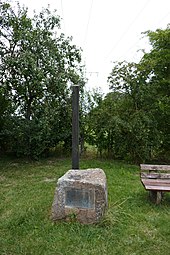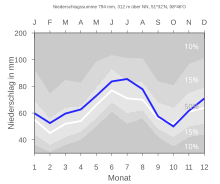Hurry
Eilern is a locality in the municipality of Bad Wünnenberg , North Rhine-Westphalia , Germany.
location
Eilern is located about four kilometers from the Bad Wünneberg district of Fürstenberg (Westphalia) , between the Sintfeld and the Paderborn plateau . The location is connected to the L744 state road.
At the local border in the north lies the Eilerberg with the Galgen court . The Eilerberg is a distinctive step in the terrain of the Paderborn plateau due to the change in geological layers and towers above the Ortslahe by 50 m.
history
Church rulers
The Kircheilern settlement existed on the site of the village of Eilern. Kircheilern was first mentioned in a document at the end of the 13th century. The farms located there belonged to the noblemen von Büren and the monasteries Bredelar , Busdorf , Dalheim , Böddeken and the Corvey monastery . In 1439 the settlement was called desolate . Presumably, Kircheilern was destroyed in the Bengel feud towards the end of the 14th century. The rights to the destroyed place first went to the Dalheim monastery, later the rights to the western part of the Eiler Mark were awarded to the Count of Westphalen .
Resettlement in 1952
The Vorwerk Eilern was settled in 1952 together with the Vorwerk Friedrichsgrund with farmers and craftsmen expelled from Pomerania and Silesia . The basis was a land reform and settlement policy in which around 230,000 ha of land in the Federal Republic of Germany were redistributed to farmers and new settlers. The group settlement procedure Eilern and Friedrichsgrund was carried out according to the law on pension assets of 1890, according to the Reichsiedlungsgesetz of 1919 and the "Law on the Implementation of Land Reform and Settlement" of North Rhine-Westphalia of May 16, 1949 with the involvement of non-profit settlement companies. Deutsche Bauernsiedlung , Düsseldorf, was designated as a non-profit settlement company . This led with a representative of the owner Friedrich Carl Graf von Westphalen zu Fürstenberg (April 22, 1898 - July 23, 1992) negotiations about the purchase of the property. The purchase agreement was signed between the two parties on June 14, 1950. The former Gut Eilern was dissolved and Friedrich Carl von Westphalen was compensated with 357,089 DM (approx. 986,000 EUR).
The buildings and structures, the expected harvest and living and dead inventory belonged to the sale object. The inventory included 20 horses (12,450 DM), 32 cattle, 32 cows, 20 cattle (49,800 DM), pigs (4,950 DM), poultry (250 DM), machines and equipment (29,066 DM), natural produce (28,789 DM), Fertilizers (DM 4,740), wood and fences (DM 5,721), cultivation of fields (DM 29,705) and household supplies (DM 1,360). Compensation for living and dead inventory was paid in cash. All other monetary claims were settled with bonds of the state of North Rhine-Westphalia or similar means of payment.
The settlement authorities initially established an expert opinion that the Eilern estate and its Friedrichsgrund suburb can be settled. The area belonged to the districts of Fürstenberg, Dalheim, Helmern and Meerhof. The wooded parcels of land in the Helmern district to the northwest of the Friedrichsgrund suburb were excluded from the settlement procedure and left in the possession of Graf Westphalens. In the Eilern / Friedrichsgrund procedure, 277.85 hectares were allocated.
In February 1951, the Rote Erde settlement company , Münster , took over the settlement project from Deutsche Bauernsiedlung. On March 13, 1951, Friedrich Carl von Westphalen zu Fürstenberg handed over the Eilern estate to Roten Erde GmbH in its full functionality. All inventory that could not be used in the later furnishing of the settlement sites and therefore remained with the seller or that was not handed over due to agreements with the settlement company was replaced by new purchases. This ensured that the interim management was carried out properly until the settlers' positions were set up and handed over to the future settlers. The additions to the inventory had to be financed by loans. 43,000 DM (approx. 120,807 EUR) were raised for the additions. Specifically, these were 10 cows (10,000 DM), 30 running pigs (3,000 DM), two Lanz Bulldogs 16 HP (11,000 DM), repair of a Lanz Bulldog built in 1939 (1,800 DM), four combined Imbert cars (wood carburetor according to Georg Imbert , 8,400 DM), two used binding mowers (DM 2,500), two 2 meter fertilizer spreaders (DM 1,100), a blower for hay and grain (DM 1,500), small devices (DM 1,200) and other items (DM 2,500).
16 new farms were built in Eilern and five in Friedrichsgrund. That was 15 full-time jobs with an average of 14 hectares of land and six part-time jobs with 5 hectares each for a shepherd, a blacksmith, a wheelwright, a bakery with a grocery store, two farm workers and five settlers. The settlers were predominantly farmers who came from the region and had started a new existence in Silesia in the 1930s. Most of the courtyard buildings were completed in 1953. Eilern did not receive public institutions such as a church or a school. The average of 14 hectares of land turned out to be too small for economic operation. Many businesses had to be given up or became a sideline.
Location description
The courtyards in Eilern are lined up on both sides at a distance of about 100 m from a street. Originally, individual farms were planned. Because of the difficult water supply in the "dry" Sintfeld, this was not done.
On the 50th anniversary of the festival in Neu-Eilern, a memorial stone was erected in 2002 to commemorate the new settlement.
In Eilern there is the location of the German Weather Service "Wünnenberg-Eilern", ID 5699 ⊙ with two stations:
- Station H477 with automatic measurements every 10 minutes since August 16, 2004
- Station 79227 with daily precipitation data since January 1, 1941
literature
- Wolfgang Feige: The Bürener Land . Landscape guide. Series of publications Wir an Alme und Afte des Heimatverein Büren eV, p. 129.
Individual evidence
- ↑ a b c Gerhard Henkel: Land reform settlements of the 20th century in Westphalia. In: lwl.org. 2007, accessed May 2, 2020 .
- ↑ founded in 1949; 1972 merger with the German Society for Land Development, which emerged from the Society for the Promotion of Inner Colonization ; Liquidated in 1994
- ↑ a b c Bernd Nolte: Eilern / Friedrichgrund. 600 - 1952 - 2002. Young village - ancient . 2002 ( berndnolte.de [accessed on May 3, 2020]).
- ↑ Stationslexikon - Climatic Data Germany -. In: dwd.de. Retrieved May 2, 2020 .
Coordinates: 51 ° 33 ' N , 8 ° 46' E


